Note: this is from Change.org regarding afterschool funding, something Living Histories is very concerned about seeing continue. We've seen first hand the impact that out of school programming makes in the lives of the youth whom participate in it.
---------------------------------------------------------------
Urge Congress to Increase Funding for Afterschool Programs
To: Members of the U.S. Senate and Members of the U.S. House of Representatives
Started by: Josh Kramer
Rising fuel costs have already strained school budgets to the breaking point, with some even switching to four-day weeks. Yet with the economy weakening and deficits ballooning, Congress may cut funding to critical afterschool programs at a time when federal support is most needed.
Study after study shows that afterschool programs work. Participating students are less likely to be involved in crime or use drugs or alcohol. They improve their grades, attend school more regularly, are more likely to stay in school, and do better in college.
Currently, the 21st Century Community Learning Centers is under review. This is the only federal money solely dedicated to helping low-income communities establish high quality afterschool programs. More than 1.6 million children depend on 21st CCLCs. But 14 million more children throughout the country must take care of themselves after the school day ends, including almost four million students in middle-school and over 40,000 kindergartners.
Please urge Congress to increase funding for the 21st CCLC Program. Our children deserve a chance for a better future.
Sign the petition and learn more here.
Tuesday, August 25, 2009
Monday, February 23, 2009
Aboriginal Art
This is one of my favorite lessons - and perfect for the 'narrative/story telling' curriculum we are working with right now.
We introduced students to the idea of Aboriginal art last week - explaining where it came from, about indigenous people, comparison/contrast to Egyptian hieroglyphs they learned about last week, about how symbols and the need to tell the story of one's origins and land is universal. Using Aboriginal art as our platform is a GREAT place to teach all of these concepts, ultimately driving home the idea that what you choose to include and NOT to include in your story is critical. Plus, we'll work in a cool service project this week - probably letter writing or some sort of activism around indigenous rights.
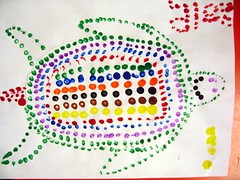
In explaining Aboriginal art and culture, we emphasize three key concepts with the students: that much Aboriginal art is about the land and 'origin stories' about people and animals, that it relies heavily on symbols, and we talk about why the Aborigines used 'dots' when painting so frequently, among the many theories being that it was to show perspective and the scope and scale of the land itself.
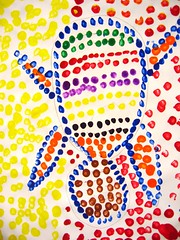
For our first project, students choose an animal that would represent them - we asked them to be able to identify specific characteristics in that animal that they saw in themselves (and, in fact, we'll do a writing activity on that this week...) and they then drew that animal and painted it in using the 'dot' style of Aborigines - we had them use Q-tips, which worked really well.
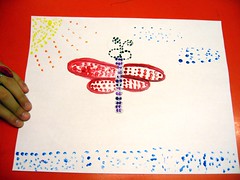
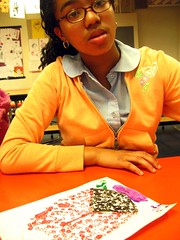
This week they'll be doing a piece inspired by Aboriginal work that shows their own 'origin story' - how they ended up where they are today. It should turn out pretty cool - the students really like the project...
We introduced students to the idea of Aboriginal art last week - explaining where it came from, about indigenous people, comparison/contrast to Egyptian hieroglyphs they learned about last week, about how symbols and the need to tell the story of one's origins and land is universal. Using Aboriginal art as our platform is a GREAT place to teach all of these concepts, ultimately driving home the idea that what you choose to include and NOT to include in your story is critical. Plus, we'll work in a cool service project this week - probably letter writing or some sort of activism around indigenous rights.

In explaining Aboriginal art and culture, we emphasize three key concepts with the students: that much Aboriginal art is about the land and 'origin stories' about people and animals, that it relies heavily on symbols, and we talk about why the Aborigines used 'dots' when painting so frequently, among the many theories being that it was to show perspective and the scope and scale of the land itself.

For our first project, students choose an animal that would represent them - we asked them to be able to identify specific characteristics in that animal that they saw in themselves (and, in fact, we'll do a writing activity on that this week...) and they then drew that animal and painted it in using the 'dot' style of Aborigines - we had them use Q-tips, which worked really well.


This week they'll be doing a piece inspired by Aboriginal work that shows their own 'origin story' - how they ended up where they are today. It should turn out pretty cool - the students really like the project...
Monday, February 16, 2009
Symbols/heiroglyphs
Last week we rolled out our new curriculum for the spring semester, ‘Story Telling’. During the course of the next twenty weeks, our students will be learning about narratives: how and why people tell stories, why our personal stories are all important, and how stories can be a vehicle for social change. They’ll be looking at ancient forms of story telling, and means by which various cultures have recorded their own and their collaborative stories over time, etc. Then, towards the second half of the semester, they will be using photography, writing, and hopefully even video to record their own stories, and stories throughout their community, with the goal of producing a piece (a book, perhaps, or photo essays – we haven’t decided just yet!) that they can share with students around the world doing similar projects. We are very excited to get this going!
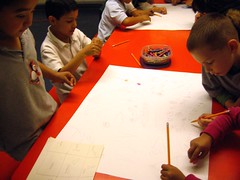
To get rolling, we spend this week talking about stories themselves, the how and why, and also looked at hieroglyphs and how symbols are used in storytelling. This is always a popular lesson – explaining how a flag is symbol, and how the ‘golden arch’ is a symbol of McDonalds always seems to do the trick. From there, students create their own symbols, and then as a group create a piece that describes either their day, or a made up story, using symbols – in particular this project is great for fostering group efforts and a sense of community amongst the students.
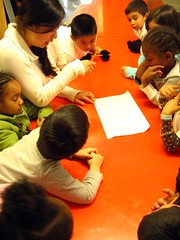
Next we’ll be looking at Aboriginal art, something we touched on last year that the kids really enjoyed.

To get rolling, we spend this week talking about stories themselves, the how and why, and also looked at hieroglyphs and how symbols are used in storytelling. This is always a popular lesson – explaining how a flag is symbol, and how the ‘golden arch’ is a symbol of McDonalds always seems to do the trick. From there, students create their own symbols, and then as a group create a piece that describes either their day, or a made up story, using symbols – in particular this project is great for fostering group efforts and a sense of community amongst the students.

Next we’ll be looking at Aboriginal art, something we touched on last year that the kids really enjoyed.
Monday, January 19, 2009
Ink monsters
Last week we created monsters, animals and plants inspired by Stefan Bucher’s Monster a Day website and book. The results were super cool, and the kids loved the project – it fit in nicely with the overall theme this month of drawing and finding inspiration in all sorts of places, and our larger goal of fostering creativity. Older students were asked to create entire back stories and lives for their characters, which also turned out really well. The only downside to the project (basically, drop ink on a paper, blast it with the compressed air and ask students to come up with a drawing that incorporates that ink blot) was discovering that those compressed air cans get cold enough to cause frost bite if used for hours on end…
Check out the results below!
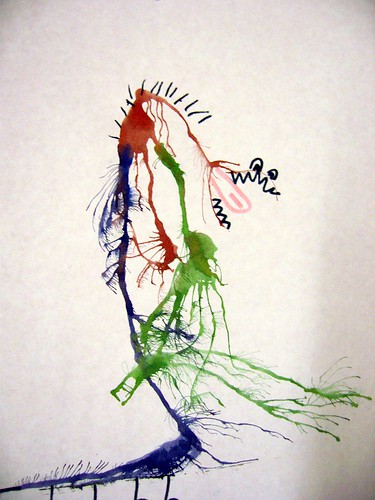
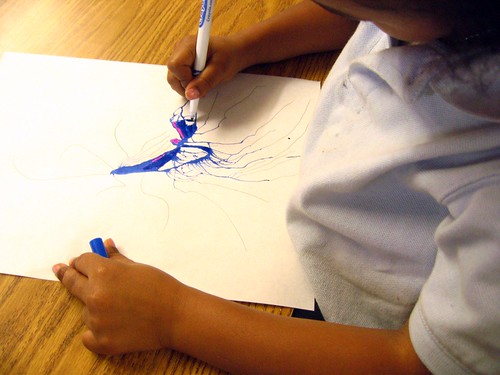
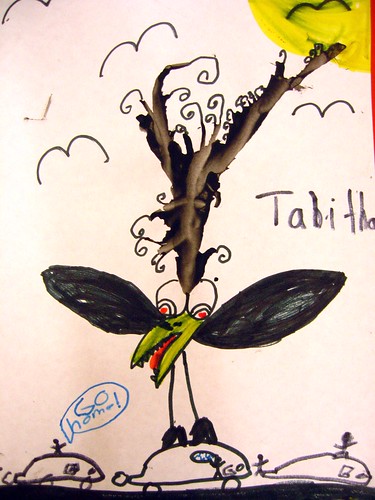
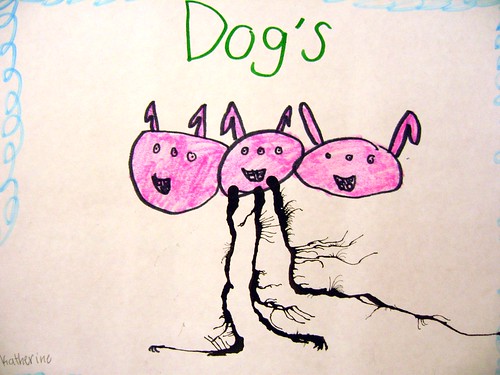
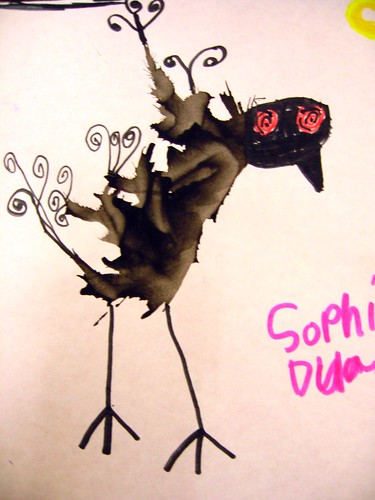
Check out the results below!





Saturday, December 20, 2008
Holiday break approaching...
We are rapidly approaching our winter break, something students and teachers alike are excited about. Every year, we have students write holiday cards for Amnesty International - it provides a great opportunity for them to do something meaningful for someone else, and is a great teaching opportunity.
This year, we wrote letters to women in Zimbabwe - the kids were able to grasp the concept of why we were doing it pretty readily, and we super into creating the cards.
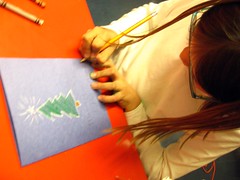
And, per tradition, we had our cookie decorating party as well.
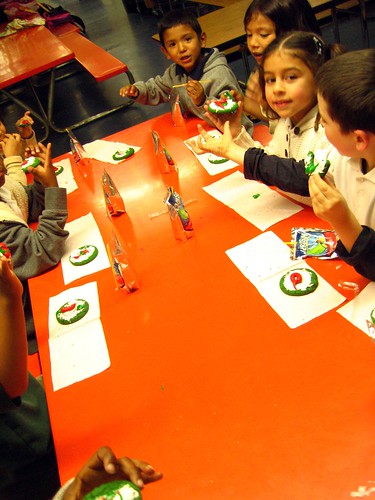
This year, we wrote letters to women in Zimbabwe - the kids were able to grasp the concept of why we were doing it pretty readily, and we super into creating the cards.

And, per tradition, we had our cookie decorating party as well.

Monday, November 03, 2008
Day of the Dead
Every year close to Halloween we look at the art of Mexico, specifically work around Day of the Dead. The students always love this project - drawing skulls, after all, IS awesome - and it's a great segway into thinking about art in different cultures, how art is used to reflect a value system and beliefs, etc. Plus, its an ideal project to work with drawing skills and techniques.
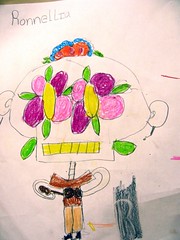
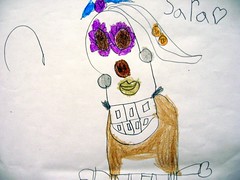


Monday, October 20, 2008
Abstract designs
Moved more formally into abstract design this week. I had the younger students work to create pieces that expressed certain feelings, the ‘catch’ being that they couldn’t use ‘real’ pictures but rather only shapes and colors. Gradually, they start to take in the idea that color can express certain feelings and emotions. Next week we’ll move onto making a bigger/more formal piece, then they’ll be doing Picasso portraits before starting their Day of the Dead pieces that they always seem to love…
Wednesday, October 15, 2008
Journals
Journaling is a big part of all of our classes. We give each student a spiral notebook that they will work out all year long (or, until they fill it up!) and they get 10 - 15 minutes at the beginning of each class to work in their books. We encourage them to write, draw, design a city, write a poem, song or movie, draw about their days, etc. The point is to foster creativity and to give them some down time to do whatever they'd like to, something they don't get a whole lot of. For older students in particular, this becomes a valuable outlet, and a place to generate ideas for later projects. For the most part though, all students, regardless of age, love this time - and the younger ones especially like to share what they did after they journal, something else we incorporate into just about every class. There is something very tangible about them having a book all to themselves, it becomes this precious object to them, and the stuff they create inside of it is pretty amazing!
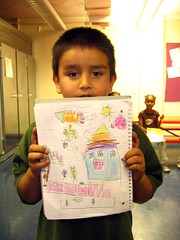
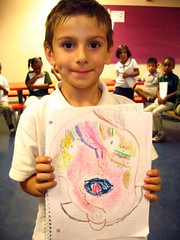
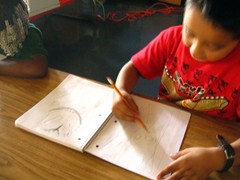
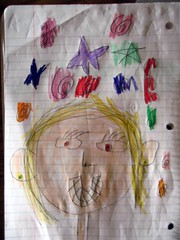




Sunday, October 12, 2008
Painting with tissue paper
Students this week did another project I picked up from my class, using tissue paper to create a design. The results were a little mixed, I need to use better tissue paper and glue, but they really liked the concept, so we’ll come back to it. I used it as my entry into teaching them about color and abstract design, which fit nicely with the larger/broader lesson plans.
Also working on their vocabulary, this year is a little bit slower going on that front, for whatever reason – I think in part because I have a lot of my teams only once a week, as opposed to twice like I normally did. It’s getting there…
Also working on their vocabulary, this year is a little bit slower going on that front, for whatever reason – I think in part because I have a lot of my teams only once a week, as opposed to twice like I normally did. It’s getting there…
Wednesday, October 01, 2008
Wax reliefs
Had the students do a project this week that I did in a ‘Do It Yourself Graphic Design’ class I’m currently taking at Art Center at Night. We did wax etchings, a fairly simple project to do (albeit, the use of chalk means it’s a little messy) and is a great way to teach about reflection and positive/negative space. By laying down a layer of chalk, then wax, and by drawing through a piece of paper over their base, the students are able to create duplicate images that look pretty cool. The oldest students really took to it, creating really cool pieces that incorporated ideas of duality, things that come in pairs, etc.
Conceptually, we are focused right now on skills that they’ll combine into some larger pieces, and we’ll be moving more into the cultural/community component of our work in the weeks to come.
The older group is interesting – kids come and go. We did some cool writing activities this week, I had them make up a story or art piece inspired by flowers from Eucalyptus trees by my gym that I picked up from the ground, something they seemed to enjoy. I work to find the right balance between giving them some structure and letting them do their own thing, seems to be developing nicely.
Conceptually, we are focused right now on skills that they’ll combine into some larger pieces, and we’ll be moving more into the cultural/community component of our work in the weeks to come.
The older group is interesting – kids come and go. We did some cool writing activities this week, I had them make up a story or art piece inspired by flowers from Eucalyptus trees by my gym that I picked up from the ground, something they seemed to enjoy. I work to find the right balance between giving them some structure and letting them do their own thing, seems to be developing nicely.
Saturday, September 20, 2008
Plant stories
Continuing with the garden/planting theme, today students dreamt up what their plant would be if it could grow up to be anything, and they also wrote from the perspective of the plant, using a first person style. The idea was to practice forms of narrative, and to also employ the use of ‘empathy’ and ‘perspective’, focusing on seeing things from another person or things point of view. It worked out pretty well, and they seemed to have a lot of fun with it.
They are also starting to finally fall into synch with the journal time, starting to learn the rhythm of the class, etc.
They are also starting to finally fall into synch with the journal time, starting to learn the rhythm of the class, etc.
Tuesday, September 16, 2008
First week
Our first week went really well - introduced the journals, and the kids really got into them. We also got the flower pots finished, and started planting them this week.
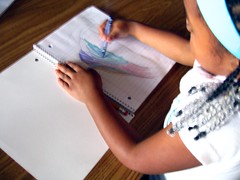
Yesterday I had them do their journal time, then copy three new words into their journals, vocabulary we'll be using this week in our projects. I had taped up some huge sheets of paper to the walls, and we are treating that as our 'word wall', so whenever we introduce a new word, one of the students gets to write it up there along with the definition, something they were way excited about. I also showed them a cool book called What It Is, by Lynda Barry to give them ideas for their journals.
I let each group pick out their plant today - I had brought in some basil and mint, some succulents, and some venus fly traps, which, needless to say, were quite popular. The deal was they had to decide as a team what they wanted, practicing both empathy and compromise. A few near melt downs, but all it all it went pretty smoothly. Once they picked their plant, I asked them to imaging what their plant would turn into if it could be anything, if it could get as big as it wanted - their drawings were pretty cool, I'll post some of them later on this week. This in turn will lead to their next project, asking them to write from the perspective of the plant on the windowsill of our classroom.
The journals are turning out super cool. I think I have them work in them as much for their benefit as for the fact that I love looking at them.
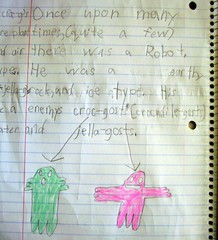
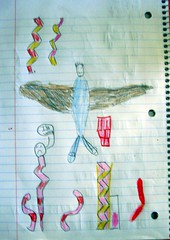
after school
lokahi outreach
creative writing
elementary school
lesson plans
teaching
teaching after school

Yesterday I had them do their journal time, then copy three new words into their journals, vocabulary we'll be using this week in our projects. I had taped up some huge sheets of paper to the walls, and we are treating that as our 'word wall', so whenever we introduce a new word, one of the students gets to write it up there along with the definition, something they were way excited about. I also showed them a cool book called What It Is, by Lynda Barry to give them ideas for their journals.
I let each group pick out their plant today - I had brought in some basil and mint, some succulents, and some venus fly traps, which, needless to say, were quite popular. The deal was they had to decide as a team what they wanted, practicing both empathy and compromise. A few near melt downs, but all it all it went pretty smoothly. Once they picked their plant, I asked them to imaging what their plant would turn into if it could be anything, if it could get as big as it wanted - their drawings were pretty cool, I'll post some of them later on this week. This in turn will lead to their next project, asking them to write from the perspective of the plant on the windowsill of our classroom.
The journals are turning out super cool. I think I have them work in them as much for their benefit as for the fact that I love looking at them.


after school
lokahi outreach
creative writing
elementary school
lesson plans
teaching
teaching after school
Tuesday, September 09, 2008
Back to school...
First day back on site was yesterday, spent most of the afternoon lugging my stuff back into my room and getting set up, was a bit of a pain on one hand, but nice to be forced to get re-organized on the other. Missing a few things, to be expected, taking the loss of my cheap CD player as a sign to get an ipod dock and take things up a notch this year...
Due to first day chaos and schedule mix ups, I only actually taught one out of my three groups, which was fine. 3rd graders, several of whom I've had off and on over the past three years. They are a really good group, really chill, laid back, almost unnervingly so for their age group! We talked about the class, the concept of community and how that is what makes our class unique, and about projects we'd do. I let them all pick a spiral notebook to use as their journal for the year (.10 each at Target, I got a bit out of hand and bought about 250 of them, but seriously, I won't find them that cheap again all year!) - I'm continuing what I started last year, taking the first ten minutes of class and giving that completely to them, allowing them to do whatever they want in the journals themselves. Then, we did our first 'group' project, a little cheesy and hippie of me, I'll admit, but it was a cool project. I had them divide themselves into groups of equal numbers - again, stressing community and collaboration - then as a group they decorated these cool but cheap plastic flower pots I bought for them, the idea being that we'll plant them and have cool decor in our windows while also symbolically growing and creating together as a group. The pots turned out pretty cool, they were way into doing them, and they surprised me with their ability to get into groups and navigate the sharing aspect of the project with minimal involvement on my part.
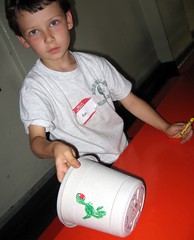
Today I did a repeat of that with my younger team, a 1st/2nd grade mix, nearly all kids I've had before. This age always is a tough one to manage in the after school setting, I have no idea why, it just is, so I had to be a little more heavy handed the first day out than I would have liked, but I was thinking of my friend Matt and his 'lay it on heavy, THEN be nice' theory. I'm never very heavy handed, really, and I always bring all discipline back to the concept of community and respect and how actions have to fit within those parameters, but I DID find myself being way more of the old school schoolmarm than I ever normally am. The flower pot project had slightly different results with them - two of the groups nailed it, were able to figure out a system for sharing and fall right into it with no stress (one of them being a group of first graders who settled the 'who goes first' dispute with the oft neglected but highly effective negotiating strategy of a few well moderated rounds of Rock, Paper, Scissors), two of the other groups didn't fare so well, in both cases the group being rocked askew by students that are suffering from some fairly intense emotional issues. So it goes - I try to get the other students to recognize that those particular students might have unique needs, and in turn, get the students prone to sinking the ship to realize their role within the community structure, but one can only do so much...
Also worked with my 'elective' group today, the mix of older kids that choose to take my class. As they year is young, I only have five as of now, all girls, 5th and 6th graders. Would be down for more kids and some diversity, but also would be pretty stoked if I had that set up for an hour on every Tue, Wed and Thur, as is the plan now - we'd get a ton of stuff done. Gave them journals today, talked about projects, and we did a writing exercise - myself included, the nice thing about having a class that small of older students - that I read about over the summer from a writer, Abigail Thomas, who has a book on writing memoirs. The basic framework is that you write about a time in your life - you defining what time means, be it a decade, a season, and event or a day - using only three word sentences, no more, no less. It's a pretty challenging thing to do, but one of those challenges that breaks barriers, gets you to think. They took to it better than I thought they would, we'll get back to it more tomorrow.
after school
lokahi outreach
creative writing
elementary school
lesson plans
teaching
teaching after school
abigail thomas
Due to first day chaos and schedule mix ups, I only actually taught one out of my three groups, which was fine. 3rd graders, several of whom I've had off and on over the past three years. They are a really good group, really chill, laid back, almost unnervingly so for their age group! We talked about the class, the concept of community and how that is what makes our class unique, and about projects we'd do. I let them all pick a spiral notebook to use as their journal for the year (.10 each at Target, I got a bit out of hand and bought about 250 of them, but seriously, I won't find them that cheap again all year!) - I'm continuing what I started last year, taking the first ten minutes of class and giving that completely to them, allowing them to do whatever they want in the journals themselves. Then, we did our first 'group' project, a little cheesy and hippie of me, I'll admit, but it was a cool project. I had them divide themselves into groups of equal numbers - again, stressing community and collaboration - then as a group they decorated these cool but cheap plastic flower pots I bought for them, the idea being that we'll plant them and have cool decor in our windows while also symbolically growing and creating together as a group. The pots turned out pretty cool, they were way into doing them, and they surprised me with their ability to get into groups and navigate the sharing aspect of the project with minimal involvement on my part.

Today I did a repeat of that with my younger team, a 1st/2nd grade mix, nearly all kids I've had before. This age always is a tough one to manage in the after school setting, I have no idea why, it just is, so I had to be a little more heavy handed the first day out than I would have liked, but I was thinking of my friend Matt and his 'lay it on heavy, THEN be nice' theory. I'm never very heavy handed, really, and I always bring all discipline back to the concept of community and respect and how actions have to fit within those parameters, but I DID find myself being way more of the old school schoolmarm than I ever normally am. The flower pot project had slightly different results with them - two of the groups nailed it, were able to figure out a system for sharing and fall right into it with no stress (one of them being a group of first graders who settled the 'who goes first' dispute with the oft neglected but highly effective negotiating strategy of a few well moderated rounds of Rock, Paper, Scissors), two of the other groups didn't fare so well, in both cases the group being rocked askew by students that are suffering from some fairly intense emotional issues. So it goes - I try to get the other students to recognize that those particular students might have unique needs, and in turn, get the students prone to sinking the ship to realize their role within the community structure, but one can only do so much...
Also worked with my 'elective' group today, the mix of older kids that choose to take my class. As they year is young, I only have five as of now, all girls, 5th and 6th graders. Would be down for more kids and some diversity, but also would be pretty stoked if I had that set up for an hour on every Tue, Wed and Thur, as is the plan now - we'd get a ton of stuff done. Gave them journals today, talked about projects, and we did a writing exercise - myself included, the nice thing about having a class that small of older students - that I read about over the summer from a writer, Abigail Thomas, who has a book on writing memoirs. The basic framework is that you write about a time in your life - you defining what time means, be it a decade, a season, and event or a day - using only three word sentences, no more, no less. It's a pretty challenging thing to do, but one of those challenges that breaks barriers, gets you to think. They took to it better than I thought they would, we'll get back to it more tomorrow.
after school
lokahi outreach
creative writing
elementary school
lesson plans
teaching
teaching after school
abigail thomas
Tuesday, March 11, 2008
Aboriginal Art continued
Class today went well – we started out with journaling again, students are really starting to fall into synch with that, been doing it for about four weeks now. Trick is to keep them on that cycle and engaged without having them get bored. I like giving them to freedom to do whatever they want and think they need it, but I also try to keep a few prompts/inspirations handy just in case. 1st graders did their usual mix of interesting stuff – some just scribbled and colored, others really got focused in and made some interesting stuff – Tabitha in particular today made a really cool desert type of landscape, and Maritza did an interesting abstract design. Monica, one of our third graders, wrote about having a bad day – feeling lonely, getting pinched by someone. I like to think that the time helps them, really work to structure it so it doesn’t feel like a lesson or activity, just something for them. I think getting their work compiled into actual books will help a lot – they can go over old work, get a sense that it’s their own personal sketchbook/journal.
Continued with the Aboriginal art work today. Reviewed key points from last week – use of symbolism, style of painting with dots, stories. They are retaining the info really well, seem to click and ‘get it’. They really liked doing the dot style painting – Sumner had a good idea and went out before class and bought Q-tips and we had them paint with those instead of paintbrushes – cut out the urge to paint in a more traditional style, and I think they liked the novelty of doing something different.
Excited about shaping up this Indigenous Art theme I’ve been teaching into an actual curriculum – students have been good about being the guinea pigs of sorts for it!
Continued with the Aboriginal art work today. Reviewed key points from last week – use of symbolism, style of painting with dots, stories. They are retaining the info really well, seem to click and ‘get it’. They really liked doing the dot style painting – Sumner had a good idea and went out before class and bought Q-tips and we had them paint with those instead of paintbrushes – cut out the urge to paint in a more traditional style, and I think they liked the novelty of doing something different.
Excited about shaping up this Indigenous Art theme I’ve been teaching into an actual curriculum – students have been good about being the guinea pigs of sorts for it!
Wednesday, November 28, 2007
Khasma
Today I had the kinders do a crafty project since they had been doing a lot of drawing lately. We did Khasma, or Good Luck Hands, as a continuing theme of art from other cultures. The hands themselves are fairly universal – used in Arabic/North African culture, Jewish culture as well as in other forms around the world.

They love doing anything with their hand anyway – tracing, etc. – so they were excited to get to draw their hand, cut it out, then decorate it. I am also amazed at their word retention – we started out class today with a longer ‘discussion’ time than normal, and I am really impressed by the terms (community, abstract, culture) they have been able to remember and understand.

6th graders today got to catch up, and we talked more about our writing club. We are having a party/reading next Friday – to my amusement they wanted coffee, to make it like a coffee house reading. Their writing is coming along nicely, I’m looking forward to maybe editing and helping them type it up a bit. Wendy lost a few pages of her work when her mom spilled Kool Aid on her notebook, but I convinced her to make a poem about the ‘Kool-Aid tragedy of 2007.’ We decided to keep working on our novels through next week, going beyond the November time frame we set, with some time next week going to editing and selecting what they want to read. We also decided that December/January are going to be poetry months, with an emphasis on Haiku’s. They were very excited when I suggested that our reading at the end of January be a ‘sushi’ party…now that I brought it up, they’ll hold me to it, so I’ll have to figure out something cool!

They love doing anything with their hand anyway – tracing, etc. – so they were excited to get to draw their hand, cut it out, then decorate it. I am also amazed at their word retention – we started out class today with a longer ‘discussion’ time than normal, and I am really impressed by the terms (community, abstract, culture) they have been able to remember and understand.

6th graders today got to catch up, and we talked more about our writing club. We are having a party/reading next Friday – to my amusement they wanted coffee, to make it like a coffee house reading. Their writing is coming along nicely, I’m looking forward to maybe editing and helping them type it up a bit. Wendy lost a few pages of her work when her mom spilled Kool Aid on her notebook, but I convinced her to make a poem about the ‘Kool-Aid tragedy of 2007.’ We decided to keep working on our novels through next week, going beyond the November time frame we set, with some time next week going to editing and selecting what they want to read. We also decided that December/January are going to be poetry months, with an emphasis on Haiku’s. They were very excited when I suggested that our reading at the end of January be a ‘sushi’ party…now that I brought it up, they’ll hold me to it, so I’ll have to figure out something cool!
Tuesday, November 27, 2007
Catch up time...
Today was a catch up day – more or less using most of this week for that. Trying to get their work all organized into their folders, and give them a chance to finish up projects they might not have been able too. I keep the class moving pretty fast to keep them interested and engaged, but I also like to give them a chance to go back and finish stuff up. I’m big on giving them new projects, or at least a new perspective on projects, each class session, so sometimes we need a day to go back and get caught up.
My 1st/2nd grade group is starting to do much better overall, they are finally mellowing down a bit and can get focused. I guess they were a bit rowdy when Sumner subbed for me last week when I had jury duty – they came to class armed with ‘I’m sorry notes’ yesterday. The notes they wrote were pretty awesome (‘I’m sorry I kept getting out of my seat and yelling’ “I’m sorry I was disrespecting the sissors’, ‘I am going to be a different person’ etc…) but Sumner didn’t seem to think they were all that bad, guess their teacher thought otherwise though.
My 1st/2nd grade group is starting to do much better overall, they are finally mellowing down a bit and can get focused. I guess they were a bit rowdy when Sumner subbed for me last week when I had jury duty – they came to class armed with ‘I’m sorry notes’ yesterday. The notes they wrote were pretty awesome (‘I’m sorry I kept getting out of my seat and yelling’ “I’m sorry I was disrespecting the sissors’, ‘I am going to be a different person’ etc…) but Sumner didn’t seem to think they were all that bad, guess their teacher thought otherwise though.
Monday, November 26, 2007
Right Brain Drawing
Today we did some more work with the Right Brain Drawing idea. The older groups first started out with a writing activity – building on some of the stuff we did for Amnesty International. I had them do a creative writing exercise, imagining that they had a completely different life – born to a different family in a different country, etc – they could be anything, rich, poor, homeless, a circus family, an African family, etc. They then wrote details – did they go to school, what was their family like, where did they live, etc. It went over pretty well, the 6th graders in particular did a great job with it. We then a few more of the Betty Edwards Right Brain drawing exercises – teaching drawing has proven to be really effective. It lets me explain larger ideas of pushing ourselves/not censoring ourselves or stopping because something is not perfect. It can be a frustrating process for them, but I’m finding I’m able to use that as an effective teaching tool at times. Today all three groups – 6th, 1st/2nd and 5th all did the blind contour drawing – they had to draw the lines of their hands while not looking at their paper – and the upside down line drawing.

It’s cool to see them get excited about what they can accomplish. Trying to figure out the best direction to go now with the drawing, and keep a balance with other projects – want to keep a continuity (something that is critical when teaching after school) going but also don’t want to get them feeling too burdened down.
The novel writing is going well – kids are writing way more than I thought, which is cool. We officially decided to expand this project into a writers club to last for the rest of the year, I’m working on thinking of some cool themes to keep them motivated and focused.

It’s cool to see them get excited about what they can accomplish. Trying to figure out the best direction to go now with the drawing, and keep a balance with other projects – want to keep a continuity (something that is critical when teaching after school) going but also don’t want to get them feeling too burdened down.
The novel writing is going well – kids are writing way more than I thought, which is cool. We officially decided to expand this project into a writers club to last for the rest of the year, I’m working on thinking of some cool themes to keep them motivated and focused.
Monday, November 19, 2007
Upside down drawings Monday Nov 19th
Today was a lot of fun. We started out class with a creative writing activity – I was going to have them do another Amnesty letter, but I decided we hadn’t done enough fun creative writing lately. I had them write me a Thanksgiving story – it could be anything, a story, a poem, a newspaper article, etc - from the perspective of a turkey. They all – including my 1st/2nd grade team – came up with some impressive stuff! The 6th grade team in particular took the open ended aspect of the project to heart – some of them wrote letters back to their ‘turkey families’ saying they had survived another Halloween, some wrote from the dead, one wrote a poem, one a rap, and another one wrote a ‘manifesto’ of sorts, threatening doom to the human population if the turkey eating continued. My favorite was a student who wrote about how, as a turkey, she was in the forest and was captured, but thankfully her captures were ‘hippies’ that were vegetarians and brought her to a happy farm.
I also had a meeting with my novel writers – collectively, we are over 150 pages written now, which is way cool. We talked about what is working for us, what things were hard, and what ideas we had to keep going through the month. Some students also said they were upping their goals, pushing to write two pages a day for the rest of the month. I am really surprised by which students took to this project – not the ones I would have expected based on their performance in class and my overall interactions with them, it’s cool to get to know them at a different level/in a different way because of this project. We also talked about making this project into a ‘club’ that could go all year long, something they seemed interested in doing.
We also started the Edwards upside down line drawings today – the student reactions were different. Most embraced it and were excited to see their results, though some got frustrated – its’ a good exercise to teach them to try to overcome their frustrations, to realize they have to let go and not be focused on making everything perfect. It’s the same reason I make a big deal about them not worrying about spelling – we always fix spelling, of course, but many of them use that as a reason to not write at all, and I find I spend a lot of my time, both with our writings and our art, getting them to work beyond their own censorship/frustrations. Excited to see how this all progresses in the next few weeks. Also working to incorporate some lessons that can tie them into the organization in Africa we’ll be working with…
I also had a meeting with my novel writers – collectively, we are over 150 pages written now, which is way cool. We talked about what is working for us, what things were hard, and what ideas we had to keep going through the month. Some students also said they were upping their goals, pushing to write two pages a day for the rest of the month. I am really surprised by which students took to this project – not the ones I would have expected based on their performance in class and my overall interactions with them, it’s cool to get to know them at a different level/in a different way because of this project. We also talked about making this project into a ‘club’ that could go all year long, something they seemed interested in doing.
We also started the Edwards upside down line drawings today – the student reactions were different. Most embraced it and were excited to see their results, though some got frustrated – its’ a good exercise to teach them to try to overcome their frustrations, to realize they have to let go and not be focused on making everything perfect. It’s the same reason I make a big deal about them not worrying about spelling – we always fix spelling, of course, but many of them use that as a reason to not write at all, and I find I spend a lot of my time, both with our writings and our art, getting them to work beyond their own censorship/frustrations. Excited to see how this all progresses in the next few weeks. Also working to incorporate some lessons that can tie them into the organization in Africa we’ll be working with…
Thursday, November 15, 2007
Thursday Nov 15th
Today was our all Kinder day. I decided to push them a bit – wanted to find out if some of the Betty Edwards projects from Drawing on the Right Side of the Brain were too advanced for them. I had them focus on trying to draw their hand without looking, and also on doing the upside down drawing – the goal of all being to get them to think about drawing with they see and not always the symbols for what they see. They are still pretty little for this – development wise they are very much so still at the symbol phase - but some of them really latched onto it and they weren’t nearly as frustrated as I had anticipated they would be, which was exciting to see.
Tuesday, November 13, 2007
Polaroid project/more abstract drawing
Back in school after having Monday off. Had students work more on drawing skills – still working with abstract forms, getting them ready to move into flat drawing and contour stuff. Had the 1st/2nd grade group get started with a definition, then we talked a bit about culture and some of the Amnesty stuff we did the week before. I also introduced them to the work of Dan Eldon, something we’ll go back to continuously.

Then, we did an abstract project using a Polaroid portrait I took of each of them as the basis – they glued the photo down then did abstract work around it, sort of framing it, with the idea being that they were going to ‘theme’ their abstraction around their photo. I got the idea from a book I had on collaging/altered imaging – like how it has turned out thus far, and the students were way into the way the Polaroid tweaks their image.


Then, we did an abstract project using a Polaroid portrait I took of each of them as the basis – they glued the photo down then did abstract work around it, sort of framing it, with the idea being that they were going to ‘theme’ their abstraction around their photo. I got the idea from a book I had on collaging/altered imaging – like how it has turned out thus far, and the students were way into the way the Polaroid tweaks their image.

Subscribe to:
Posts (Atom)
